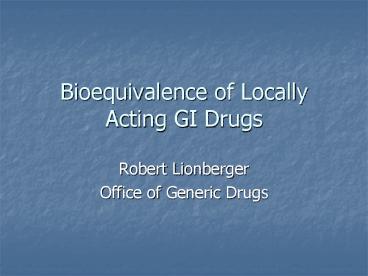Bioequivalence of Locally Acting GI Drugs PowerPoint PPT Presentation
1 / 22
Title: Bioequivalence of Locally Acting GI Drugs
1
Bioequivalence of Locally Acting GI Drugs
- Robert Lionberger
- Office of Generic Drugs
2
Dissolution
- Dissolution controls delivery to the site of
action
3
Pharmacokinetics
- Pharmacokinetic (PK) studies of locally acting
drugs are related to safety - A common claim PK of locally acting drugs is not
correlated with therapeutic effect. - While this statement is often true, we need to
carefully consider its implications for
bioequivalence testing. - PK of GI acting drugs is related to formulation
performance
4
Mesalamine
- Introduction
- Anti-inflammatory targeting colon
- Rapidly absorbed from intestine
- Can be measured in plasma
- Extensively metabolized in gut wall
5
Formulation Approaches
- Pro-drug
- sulfasalazine (Azulfidine)
- balsalazide (Colazal)
- olsalazine (Dipentum)
- Delayed Release
- Asacol
- Pentasa
6
Sulfasalazine
- Sulfasalazine (SS) Cleaved in the colon to form
- sulfapyridine (SP)
- mesalamine (5-ASA)
- 81 of SS and SP is recovered in urine
- SP is quickly absorbed
- 5-ASA is further metabolized
7
PK for Bioequivalence
- SP was used for BE study endpoint
- Not further metabolized
- Rapidly absorbed
- Lower variability
8
Pentasa
- Slow release coated microgranule formulation
- Releases throughout the intestine (Duodenum,
jejunum, ileum, and colon) - 60 release in the intestine
- 23 absorbed
9
Pentasa Bioequivalence
- PK study attempted for bioequivalence between
pilot and production scale products - Replicate design because of high variability
- IVIVC established to demonstrate future
equivalence of formulations
10
Asacol
- Delayed release coated formulation
- pH sensitive dissolution ( pH 7 or greater)
- Release in terminal ileum and colon
11
Dissolution Studies of Mesalamine
M. W. Rudolph, S. Klein, T. E. Beckert,
H. Petereit, and J. B. Dressman. A new
5-aminosalicylic acid multi-unit dosage form for
the therapy of ulcerative colitis. Eur J Pharm
Biopharm, 51(3)183190, May 2001.
12
Comparative PK
Cmax AUC
Pellet 429 /- 262 968 /- 629
Tablet 1241 /- 1305 2205 /- 1767
13
Clinical Comparisons
- Clinical studies have not demonstrated
significant difference between existing
formulations (Sandborn 2002)
N Balsalazide Asacol
101 62 45
98 65 53
173 52 49
Placebo Asacol 0.8 g/d Asacol 1.6 g/d
N 63 58 68
Success 39.7 58.8 65.5
An Oral Preparation of Mesalamine as Long-Term
Maintenance Therapy for Ulcerative Colitis A
Randomized, Placebo-Controlled Trial. Hanauer,
et al, Ann Int Med, (124) 204-211,1996
W. J. Sandborn, Rational selection of oral
5-aminosalicylate formulations and prodrugs for
the treatment of ulcerative colitis, Am J
Gastroenterol 97(12), 2939 (Dec 2002),
14
Mesalamine Summary
- How to distinguish current products
- Dissolution (yes)
- PK (likely, but high variability)
- Clinical comparison (challenging)
15
Acarbose
- Intestinal enzyme inhibitor to reduce glucose
absorption - No measurable absorption
- Pharmacodynamic endpoint
- Changes in glucose and/or insulin
16
Cholestyramine
- Lowers cholesterol by bile acid sequestering
- No detectable absorption
- 1993 Guidance
- In vitro binding assay to demonstrate
bioequivalence - Measured affinity and capacity
17
BCS Classification
- Systemic Drugs
- High permeability and high solubility drugs in
rapidly dissolving dosage forms are eligible for
waivers of in vivo bioequivalence studies - Extend to GI acting drugs?
- High solubility drugs in rapidly dissolving
dosage forms are eligible for waivers of in vivo
bioequivalence studies
18
Role of PK Systemic
19
Role of PK GI acting
20
Potential Framework
- Dissolution testing
- Conditions chosen based on understanding of
formulation - Pharmacokinetics/Pharmacodynamics
- Confirm dissolution testing
- Systemic exposure
- In vitro assay for excipient interactions
- Most relevant when mechanism of action is binding
or sequestration
21
Discussion
- Need ACPS input on
- Role of pharmacokinetic studies
- Role of in vitro dissolution tests
- Role of clinical studies
22
Discussion Questions
- For locally acting GI drugs is PK, if measurable,
an in vivo test sensitive to formulation
performance and useful as a part of a
determination of bioequivalence? - What drug specific information would aid FDA in
interpreting the results of a PK study on a GI
acting drug with respect to a conclusion about
bioequivalence? - When is it possible to use dissolution testing
alone to demonstrate bioequivalence of GI acting
drugs? - When should comparative clinical trial studies be
conducted to demonstrate bioequivalence? - Should BCS based biowaivers be granted for GI
acting drugs?

